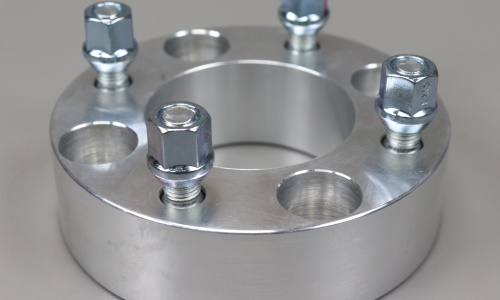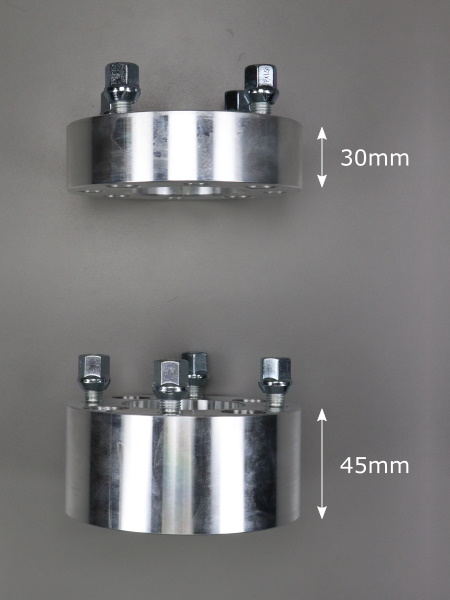Home > general information > Tips and Guides > Technical guides > Quad ATV >
Choose your wheel spacers for quad
The essentials to know to choose your spacers
A track widener widens the track of the quad and obtains a wider vehicle on the ground.
What is a track widener?
The wheel spacers are in the form of wedges which are positioned between the hub and the rim to lengthen the gap between the two wheels and thus widen the center distance of the tires. Lane wideners can be purchased and used par pair and can be installed in the front as well as in the rear of the vehicle. For optimal adjustment, it is recommended to opt for the same thickness so that the car is as "straight" as possible.
![]()
Features of wheel spacers
There are different models of expanders, each with different attachment systems:
– spacers with stud extender. All you have to do is screw these extensions onto the original studs, then put on the spacer. And finally, the rim and the final tightening of the studs with the original nuts.
A track widener is used for technical and aesthetic reasons in order to widen the tracks of your vehicle so that the wheels reach the edge of the fenders or to have better road holding. We therefore change the offset (ET) of the rim.
– spacers with bolts: these spacers have built-in bolts allowing the spacer to be fixed both to the spider and to the wheel:
– spacers with single bolts: they have bolts that are longer than the original one and adapted to the width of the spacer.
– spacers with double bolts: these spacers have large tracks and bolts allowing the spacer to be fixed both to the hub and to the wheel.
![]()
Materials choice
There are different materials:
- The pHD : High density polyethylene. It is an extremely resistant material and lighter than aluminum. Recommended for quads cross or sports.
- Aluminum: it is the most resistant material. Ideal for utility quads and SSV There are several thicknesses of spacers: There are several thicknesses of spacers according to the manufacturers:
- 25mm: exclusively at Moose Racing, in machined aluminum with integrated studs
- 30mm: at Art Racing, in machined aluminum with integrated studs
- 35mm: at XRW, in aluminium: product dedicated to SSV
- 38mm: exclusively at Moose Racing, in machined aluminum with integrated studs
- 45mm: in PHD or ALU with extensions in aluminum cut in the mass with integrated studs
Each manufacturer has its exclusives.

![]()

Tip
The most common thicknesses are 30mm and 45mm. You should know that the thicker the spacer, the more stable your quad will be (in handling) but the heavier the steering will be. Which is an advantage in a straight line, but it can quickly become a bit tiring in turns.
We advise mounting 45mm front + rear for most sport/recreational quads.
By using wheel spacers you will get a wider vehicle with a better wheelbase and therefore better road holding which will allow you to approach curves with greater efficiency and speed. Be careful to choose spacers adapted to your quad
If you regularly transport your quad on a trailer, make sure that it will always be wide enough in the event of a widening of the tracks of your quad. - If you usually ride in undergrowth or on very narrow paths, be careful to be able to pass once the quad is widened!
- When assembling your wideners, for even greater safety, do not hesitate to use thread locking glue or "Loctite" type for effective tightening of your wheel nuts and studs. You can also use thread-locking nuts.
- A last point on the premature wear of the wheel bearings. It is true that the offset of the wheels observed after fitting spacers is greater than before! so the force vertical exerted on the bearings is greater which will lead to premature wear of these. It's a fact, but this wear is really very minimal compared to the riding pleasure found on a widened and stable quad! In addition to having a very long lifespan, even with spacers, a wheel bearing only costs around twenty euros and will last several hundred hours.
The nature of the terrain is also important in the choice of tires. So if the competition takes place on sandy ground, you will choose very aggressive tires with a large pallet structure that propulsera the quad efficiently.
Once you have made your choice, consult our tutorials audiovisual media et written to install the track spacers
MEASURE THE DRILLING SPACING OF YOUR RIMS:
The center distance is the distance between the opposite holes intended to accommodate the nuts on a rim. It is imperative to respect this characteristic when changing rims or installing track spacers. The center distance is always accompanied by the number of holes in the rim parameters.
For more information, we invite you to consult the dedicated page by clicking You can consult it by clicking here..






